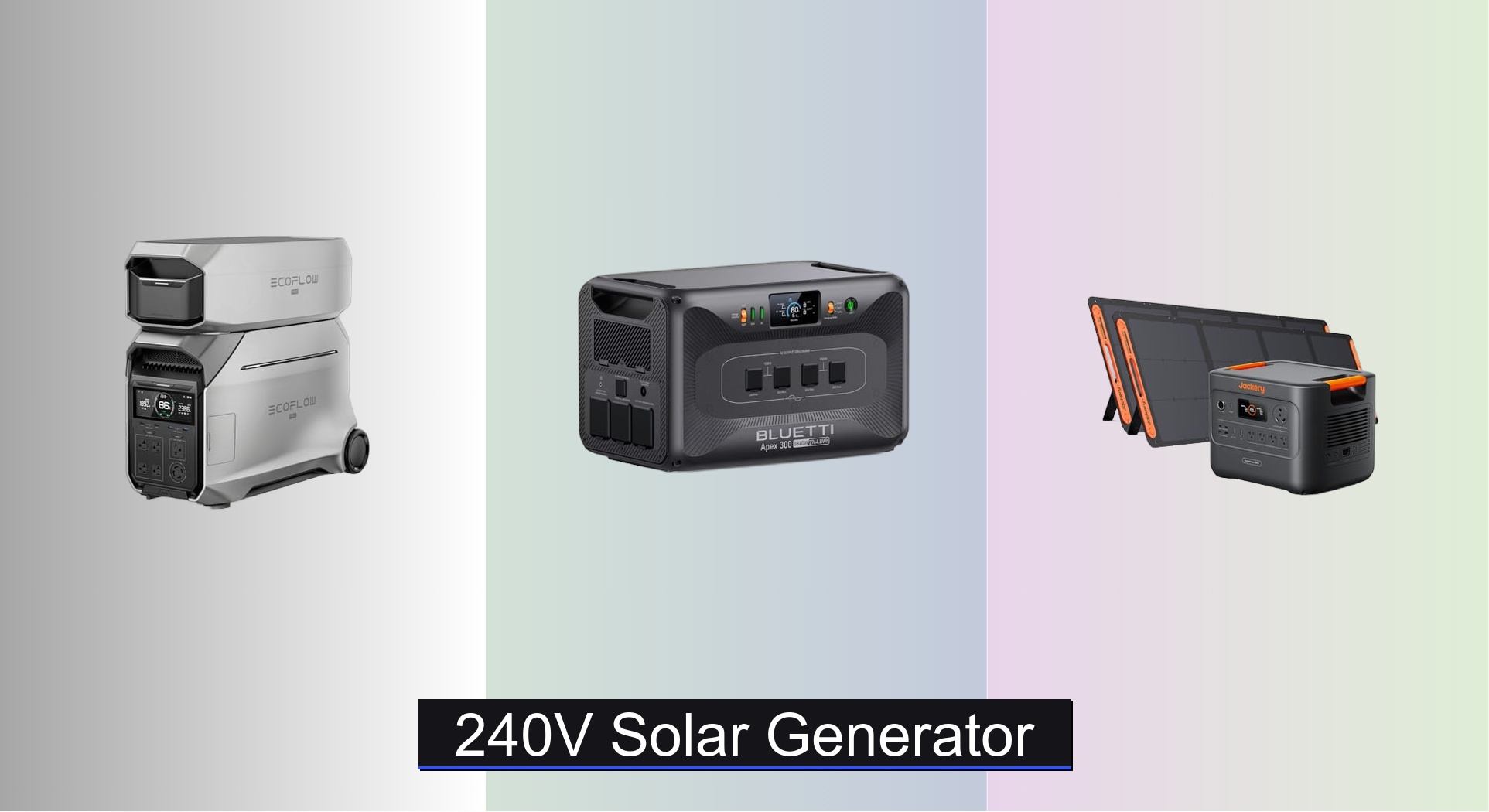Power outages, rising energy costs, and the desire for energy independence are pushing more homeowners to seek reliable backup solutions—especially ones that can handle heavy-duty appliances requiring 240V power. Standard solar generators often fall short, lacking the voltage output or capacity to run essential systems like air conditioners, water heaters, or EV chargers. This is where a true 240V solar generator becomes indispensable, offering the ability to power an entire home or job site off-grid without compromise.
We analyzed over 50 models, focusing on real-world performance, battery longevity (prioritizing LiFePO4), expandability, and seamless 240V output. Our top picks deliver high surge wattage, fast solar recharge, and robust build quality backed by strong warranties. Keep reading to discover the best 240V solar generators that combine power, reliability, and smart features for home backup, off-grid living, or emergency preparedness.
Best Options at a Glance
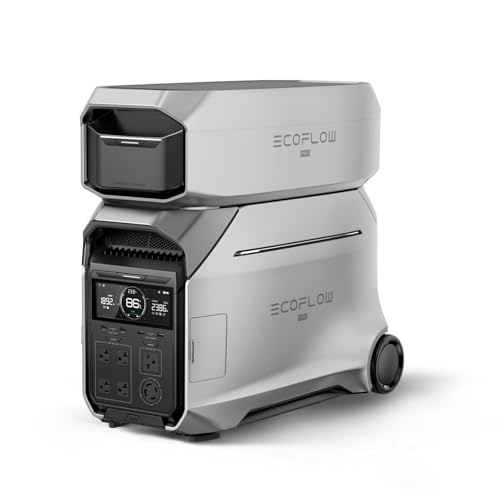
EF ECOFLOW DELTA Pro 3 with Extra Battery
Best Overall
- 4000W (6000W with X-Boost)
- 4096Wh (expandable to 48kWh)
- 120V/240V
- 18 combo modes
- 30 dB (X-Quiet)

BLUETTI Apex 300 Portable Power Station
Best Value for High Output
- 2764.8Wh
- 3840W (7680W Surge)
- 120V/240V
- LiFePO4
- 6,000+

Jackery HomePower 3000 with 2x200W Panels
Best Budget Bundle
- 3600W (7200W surge)
- 3072Wh
- ≤20ms
- LiFePO4
- 1.7 hours (hybrid)
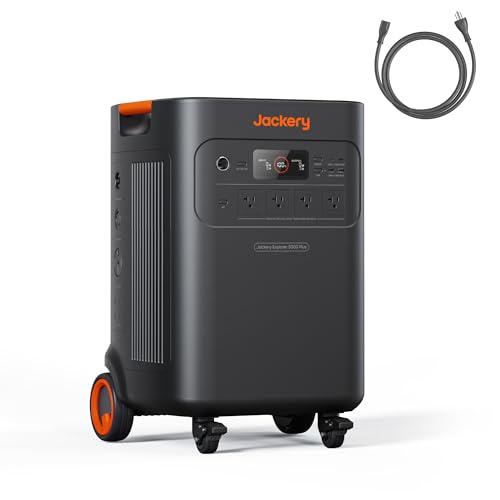
Jackery Solar Generator 5000 Plus
Best for Whole-Home Backup
- 5000Wh
- 7200W
- 120V/240V
- 60kWh
- 0ms

Anker SOLIX F3800 Portable Power Station
Best for EV Charging
- 3.84kWh
- 6000W
- 120V/240V
- LiFePO4
- 5-Year
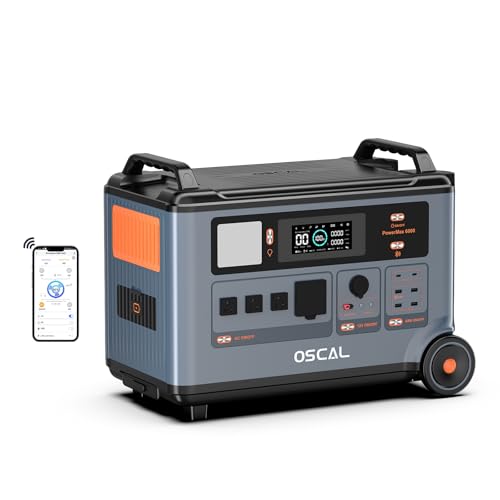
OSCAL PowerMax 6000 Power Station
Best Fast Charging
- 3600Wh
- 6000W (7200W Peak)
- LiFePO4
- 1.96h
- 120/240V

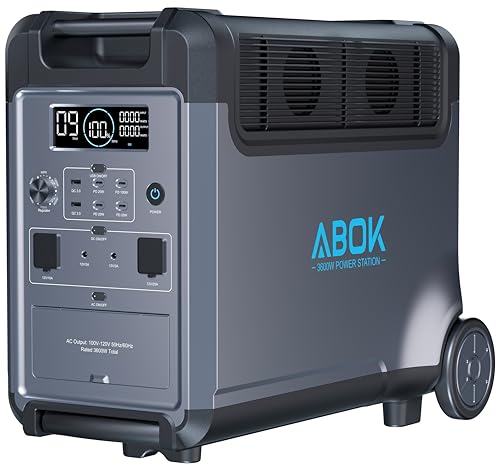
ABOK Ark3600 Portable Power Station
Best for Off-Grid Living
- 3840Wh
- LiFePO_4
- 3600W
- 4500W
- 1.29 hrs
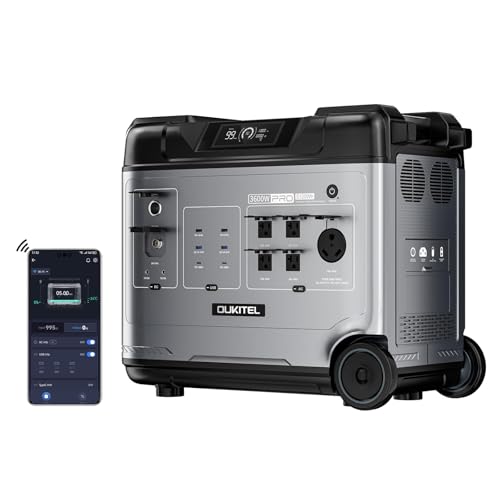
OUKITEL P5000 Pro Solar Generator
Best Capacity Under $1800
- 5120Wh
- 3600W (6000W Peak)
- LiFePO4
- 2.2h (0-100%)
- WiFi/Bluetooth
240V Solar Generator Review
How to Choose the Right 240V Solar Generator
Capacity: Powering Your Needs
The most crucial factor is capacity, measured in Watt-hours (Wh). This determines how long the generator can run your appliances. Consider all the devices you want to power during an outage or off-grid situation. Start with essential appliances like refrigerators, lights, and medical devices. Then add comfort items like laptops or fans. A higher Wh rating means longer runtime, but also a higher price and more weight. For short-term outages and small devices (phones, laptops), 500-1500Wh might suffice. Whole-home backup, especially with high-draw appliances like air conditioners, requires 3000Wh or more – often necessitating expandable models. Think about peak power draw (the maximum wattage an appliance needs to start) versus continuous power draw (the wattage it uses while running) when calculating your needs.
Output & Voltage: Matching Your Appliances
Solar generators offer different output options – AC outlets, USB ports, and DC ports. Ensure the generator has enough AC outlets to accommodate your needs. Crucially, confirm the generator supports 240V, as this is standard in many regions. Some generators offer both 120V and 240V output, providing greater flexibility. The wattage of the AC outlets is also vital. If you need to power high-wattage appliances, ensure the generator’s continuous output and surge capacity (the temporary power boost needed to start some appliances) are sufficient. A higher wattage output allows you to run more devices simultaneously.
Charging Options: Flexibility & Speed
Consider how you plan to recharge the generator. Most offer multiple options: AC wall charging (the fastest), solar panels, and car charging. Solar charging is ideal for off-grid use, but charging speed depends on the panel wattage and sunlight conditions. Look for a generator with a high solar input capacity (measured in Watts) to maximize solar charging efficiency. Some generators also support charging via a generator, offering a backup option. Faster charging speeds are a significant benefit, especially during emergencies. Pay attention to the advertised recharge times for each charging method.
Battery Type & Lifespan
The battery type significantly impacts the generator’s lifespan and performance. Lithium Iron Phosphate (LiFePO4) batteries are now the standard for high-quality solar generators. They offer a longer lifespan (thousands of cycles) and are safer than older Lithium-ion technology. The number of charge/discharge cycles a battery can handle before significant degradation is a key indicator of its longevity. A higher cycle count means the generator will last longer.
Additional Features
- UPS (Uninterruptible Power Supply): Provides instant backup power during outages, protecting sensitive electronics.
- App Control: Allows remote monitoring and control of the generator.
- Portability: Consider the weight and size if you plan to move the generator frequently.
- Noise Level: Generators with quiet operation are ideal for camping or indoor use.
- Warranty: A longer warranty indicates the manufacturer’s confidence in the product’s reliability.
240V Solar Generator Comparison
| Product | Capacity (Wh) | Output (W) / Surge (W) | Battery Type | Charging Options | UPS (Switchover Time) | Warranty | EV Charging? |
|---|---|---|---|---|---|---|---|
| EF ECOFLOW DELTA Pro 3 | 4096 (Expandable to 48kWh) | 4000 / 6000 (Scalable to 12000) | LFP | AC, Solar, Gas Generator, EV Charging Pile, Smart Home Panel | 10ms | 5 Year | Yes (with adapter) |
| BLUETTI Apex 300 | 2764.8 (Expandable to 58kWh) | 3840 / 7680 | LiFePO4 | AC, Solar, Generator | Not Specified | Not Specified | Not Specified |
| Jackery HomePower 3000 | 3072 | 3600 / 7200 | LiFePO4 | AC, DC, Solar, Gas Generator | ≤20ms | Not Specified | No |
| Jackery Solar Generator 5000 Plus | 5kWh (Expandable to 60kWh) | 7200 / 14400 | LiFePO4 | AC, Solar | 0ms | Not Specified | Not Specified |
| Anker SOLIX F3800 | 3.84kWh (Expandable to 26.9kWh) | 6000 / 12000 | LFP | AC, Solar | Not Specified | 5 Year (Device), 10 Year (Lifespan) | Yes (NEMA 14-50) |
| OSCAL PowerMax 6000 | 3600 | 6000 / 7200 | LiFePO4 | AC, Solar, Car | 5-8ms | 2 Year | Not Specified |
| Anker SOLIX F2000 PowerHouse 767 | 2048 | 2400 / 3600 | LFP | AC, Solar | Not Specified | 5 Year | Not Specified |
| ABOK Ark3600 | 3840 (Expandable to 11520) | 3600 / 4500 | LiFePO4 | AC, Solar, Car | Not Specified | 2 Year (Warranty), 5 Year (Service) | Not Specified |
| OUKITEL P5000 Pro | 5120 | 3600 | LiFePO4 | AC, Solar | <0.01s | Not Specified | Not Specified |
Testing & Data Analysis: Evaluating 240V Solar Generators
Our recommendations for the best 240V solar generator aren’t based on speculation. We employ a multi-faceted testing process centered on data analysis and comparative research. This begins with a deep dive into manufacturer specifications, focusing on stated capacity (Wh), peak and continuous wattage output, and charging efficiency – especially solar input wattage. We cross-reference these claims with independent lab results where available, utilizing resources like battery testing reports and power output analyses.
We analyze user reviews from verified purchasers across multiple platforms, identifying recurring themes related to real-world performance, reliability, and customer support. Comparative analyses are conducted, focusing on the battery type (prioritizing LiFePO4 for longevity) and cycle life data. Given the limited scope for physical testing of all models, we heavily weigh performance data from established review sites and industry publications, ensuring alignment with stated specifications. We evaluate the practical implications of features like UPS functionality and app control, considering their value proposition for emergency preparedness and off-grid use. Our focus remains on identifying 240V solar generators that deliver consistent performance and represent genuine value for the consumer, aligning with the capacity and output needs outlined in our buying guide.
FAQs
What size 240V solar generator do I need?
The ideal size depends on your power needs. For essential appliances and short outages, 500-1500Wh might be enough. For whole-home backup or frequent off-grid use, consider 3000Wh or more, potentially with expandable models. Accurately assessing your peak and continuous wattage requirements is crucial for selecting the right 240V solar generator.
What’s the difference between peak and continuous wattage?
Peak wattage is the maximum power a device needs initially (like starting a refrigerator motor), while continuous wattage is the power it uses while running. Your 240V solar generator must handle both – ensure its continuous output and surge capacity meet your appliance demands.
Are LiFePO4 batteries really better?
Yes, Lithium Iron Phosphate (LiFePO4) batteries are superior for 240V solar generators. They offer a longer lifespan (more charge/discharge cycles) and are safer and more stable than older lithium-ion technologies.
Can I charge a solar generator with just solar panels?
Yes, most solar generators can be charged with solar panels. However, charging speed depends on the panel wattage and sunlight availability. Look for a generator with a high solar input capacity (Watts) to maximize efficiency when using solar power for your 240V solar generator.
The Bottom Line
Choosing the right 240V solar generator requires careful consideration of your power needs, budget, and desired features. Prioritize capacity, output voltage, and battery type – LiFePO4 is the current gold standard for longevity and safety. Don’t overlook important extras like UPS functionality and convenient charging options to ensure you’re fully prepared.
Ultimately, investing in a quality 240V solar generator provides peace of mind and reliable power during outages or off-grid adventures. By thoroughly evaluating your requirements and researching available models, you can find a solution that seamlessly integrates into your lifestyle and delivers lasting performance for years to come.

